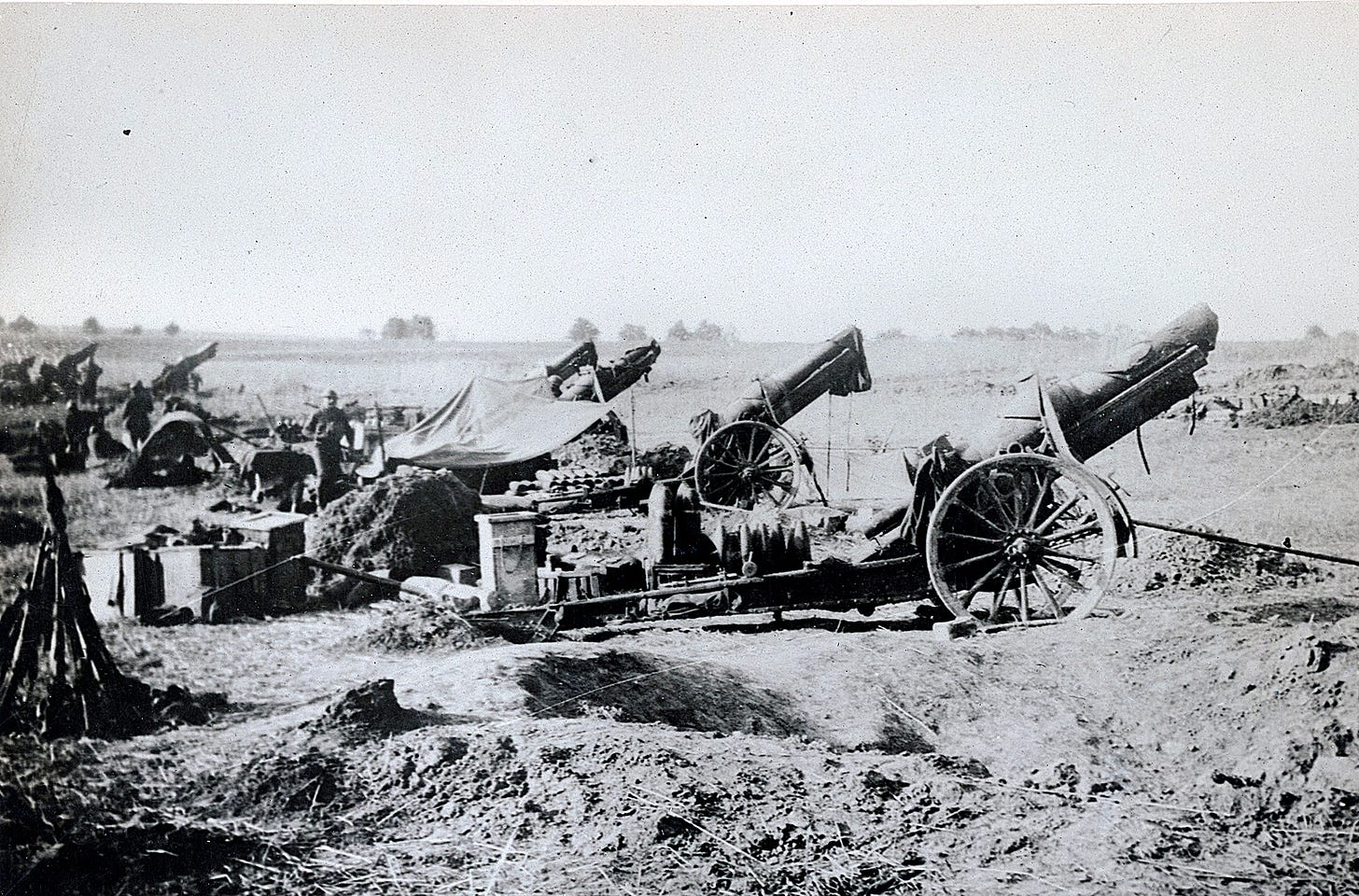First cousins died at the same battle in World War I
Sgt. Lawrence Phillips and Pvt. Robert Hughett died on the same day, at the same battle as Allied forces halted the German advance towards Paris and turned the tide in World War I
You’re reading “Echoes in Time,” a weekly newsletter by the Independent Herald that focuses on stories of years gone by in order to paint a portrait of Scott County and its people. “Echoes in Time” is one of six weekly newsletters published by the IH. You can adjust your subscription settings to include as many or as few of these newsletters as you want. If you aren’t a subscriber, please consider doing so. It’s free!
Today’s newsletter is sponsored by the Scott County Chamber of Commerce. Since 1954, the Scott County Chamber of Commerce has advocated for a strong community by supporting stronger infrastructure and leadership.
The day first cousins from Scott County fell on the same battlefield in a pivotal World War I battle
On July 18, 1918, two cousins from Scott County — Sgt. Lawrence Phillips and Pvt. Robert Hughett — died on the first day of fighting at the Battle of Soissons, a pivotal battle late in the war.
Sgt. Phillips, age 27, was the son of Perry Phillips and Mildred Phillips of Oneida. Pvt. Hughett, age 20, was the son of William “Alex” Hughett and Martha Phillips, also of Oneida. They were two of the 22 service men from Scott County who died during or just after the war, and two of 12 from Scott County who were killed in battle.
First cousins
Sgt. Phillips and Pvt. Hughett were both the grandsons of Jehu Phillips, a prominent Scott Countian who had died eight years earlier.
Jehu Phillips was the son of Joseph Phillips and Elizabeth “Millie” Lawson of Bull Creek. His father had migrated to present-day Scott County as a teenager with Revolutionary War veteran Abraham Goad, who settled on what is now known as the Vanderpool Place at New River. He met and married Millie, whose father was Randolph Lawson, another Revolutionary War veteran who was Abraham Goad’s neighbor and lived near the mouth of Paint Rock Creek, where he operated a grist mill.
Jehu married Rebecca Sexton, the daughter of Moses Sexton and Leander “Laura” Hatfield, about 1841. Both of her grandfathers, Timothy Sexton and Joseph Hatfield, were also Revolutionary War veterans. Jehu was a Union army veteran during the Civil War, as were two of his sons. He was a Baptist preacher, a chain carrier, and helped survey Scott County’s original boundary lines in 1849. He was also an early public official, serving as one of Scott County’s first county trustees. He is perhaps best known for a series of articles he wrote in the Cumberland Chronicle six years before his death — later reprinted by the FNB Chronicle — that offer valuable insight into early Scott County.
Among Jehu’s 11 children were daughters Mildred (1865-1937) and Martha (1868-1955).
Mildred married Perry Phillips (1861-1932), from Buffalo. They had 10 children, including Lawrence Phillips, who was born Jan. 19, 1891. Perry was a great-grandson of Thomas Phillips, who had married Abraham Goad’s daughter, Mary, and made the journey to present-day Scott County as part of the same caravan that included Mildred’s young grandfather, Joseph Phillips. Thomas and Joseph were brothers.
Martha married Alex Hughett (1867-1930). They had seven children, including Robert McKinley Hughett, born Feb. 11, 1898. Interestingly, Alex Hughett’s grandmother was Alex Hughett, another of Abraham Goad’s daughters, but she was not a part of the caravan to Scott County. She and her husband, William Hughett, died in Virginia.
So while first cousins Lawrence Phillips and Robert Hughett were both descended from Revolutionary War veteran Tobias Phillips (who never moved to present-day Scott County), they were both also descended from Revolutionary War veteran Abraham Goad.
Into the service
Robert Hughett enlisted in the U.S. Army on April 17, 1917. Lawrence Phillips enlisted in the Army when he turned 18, then he re-enlisted on April 6, 1917 at Columbus Barracks in Ohio.
It’s not clear whether Robert and Lawrence knew one another well here in Scott County before the war. But they did not serve together during the war. Robert was assigned to Co. E, 16th Infantry Regiment, 1st Division. Lawrence was assigned to Co. E, 9th Infantry Regiment, 2nd Division.
Robert’s regiment was one of the first American regiments to arrive on French soil during the war. It landed at St. Nazaire in late June 1917. They then spent July 1917 training in the Gondrecourt area with the French 47th Division, nicknamed the Blue Devils. The 16th Infantry later became the first U.S. regiment to fight and suffer casualties in the trenches in World War I when it repelled a German night radio near Bathelémont on Nov. 3, 1917. In the following months, the 16th Infantry fought at Ansauville, Cantigny and Coullemelle.
Lawrence’s regiment organized on Oct. 26, 1917 in France, and was a part of the Château‑Thierry campaign and the Battle of Belleau Wood in June 1918. Country music singer Garth Brooks recorded a song “Belleau Wood,” but it was based on the Christmas truce of 1914 that occurred between British and German soldiers across the Western front, not the actual Battle of Belleau Wood.
A fateful day
Robert and Lawrence came together on the same battlefield on July 18, 1918 — the first day of the Battle of Soissons. However, they were not fighting together, and each of them likely had no knowledge of the other’s presence at the battle. Lawrence and the 16th Regiment launched an attack as part of the northern assault, while Robert and the 9th Regiment attacked the southern sector.
The battle was a coordinated Allied offensive known as the Aisne-Marne Operation. With more Americans arriving in France every week, Germany had launched a series of offensives, known as the Spring Offenses, in an effort to win the war before the U.S. reached full strength. But the Allies counterattacked, and the Battle of Soissons resulted as a relentless, four-day attack intended to cut off the Soissons-Château-Thierry road and railway.
A heavy predawn fog greeted the day of July 18. The Allies opened with an artillery barrage, followed by an advance of hundreds of light French tanks with American and French infantry behind them.
Lawrence Phillips and the 16th Infantry advanced through wheat fields and small villages, engaging German machine gun nests. They broke through the first two German trench lines within hours, but casualties were heavy.
Robert Hughett and the 9th Infantry took the lead with the 2nd Division, just south of the Moroccan Division. They also inflicted heavy losses, but advanced an estimated eight kilometers in the first day, which was considered a stunning gain for WWI trench warfare.
Both Robert and Lawrence were killed on the first day of the battle. By the time the battle ended, the Allied forces had lost some 120,000 men — mostly French, but also including more than 11,000 Americans. It was a heavy toll, but the end result was a successful one. It marked the turning point of the war, halting the German advance towards Paris and broke their morale, putting them on the defensive for the remainder of the war, finally leading to the Armistice of Nov. 11, 1918.
Aftermath
Lawrence was buried at the Oise-Aisne American Cemetery in France, along with more than 6,000 other American soldiers. The 36.5-acre site includes a memorial to the fallen, and is one of eight permanent World War I American military cemeteries established outside the United States.
Robert was initially buried at the American Cemetery in Aisne, but his body was later exhumed and returned stateside, and he was buried at the Knoxville National Cemetery.
Three days later, Sgt. Hett Phillips — also from Scott County, and a distant cousin to Lawrence and Robert — was killed in the same battle. He was the son of General Phillips and Alice Cross. His great-uncle, Larkin Cross, was a man from Smith Creek who was murdered by Confederate soldiers during the Civil War. He was descended from both Abraham Goad and Randolph Lawson on his father’s side. He entered the U.S. Army on April 6, 1917 and was assigned to Co. G, 18th Infantry, 1st Division. He was involved in the Battle of Cantigny before Soissons. Like Robert, he was initially interred at the American Cemetery in Aisne before his body was returned to the states for burial at Knoxville National Cemetery.
Thank you for reading. Our next newsletters will be Threads of Life on Wednesday and The WeekenderThursday evening. Want to update your subscription to add or subtract these newsletters? Do so here. Need to subscribe? Enter your email address below!
◼️ Monday morning: The Daybreaker (news & the week ahead)
◼️ Tuesday: Echoes in Time (stories of our history)
◼️ Wednesday: Threads of Life (obituaries)
◼️ Thursday evening: The Weekender (news & the weekend)
◼️ Friday: Friday Features (beyond the news)
◼️ Sunday: Varsity (a weekly sports recap)




